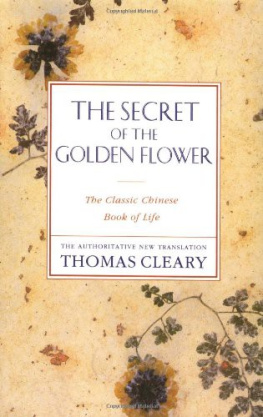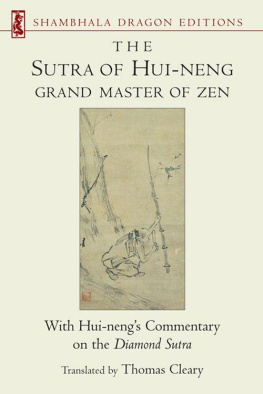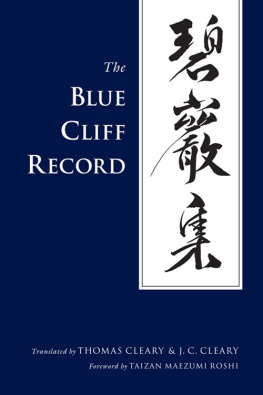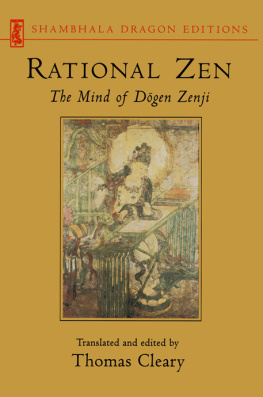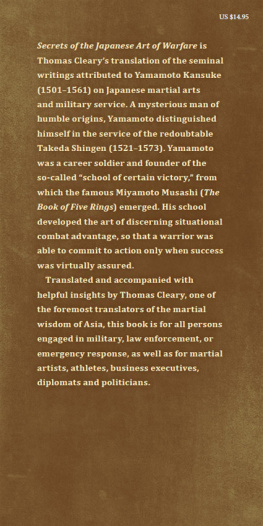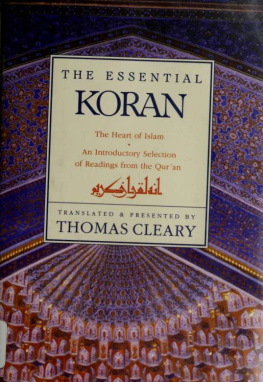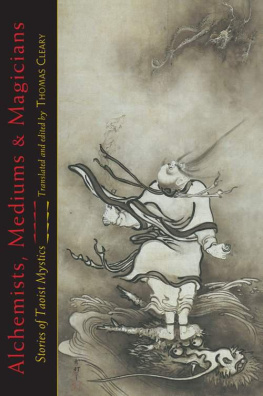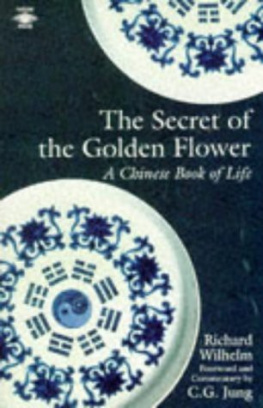Thomas Cleary - The Secret of the Golden Flower
Here you can read online Thomas Cleary - The Secret of the Golden Flower full text of the book (entire story) in english for free. Download pdf and epub, get meaning, cover and reviews about this ebook. year: 1993, publisher: HarperOne, genre: Religion. Description of the work, (preface) as well as reviews are available. Best literature library LitArk.com created for fans of good reading and offers a wide selection of genres:
Romance novel
Science fiction
Adventure
Detective
Science
History
Home and family
Prose
Art
Politics
Computer
Non-fiction
Religion
Business
Children
Humor
Choose a favorite category and find really read worthwhile books. Enjoy immersion in the world of imagination, feel the emotions of the characters or learn something new for yourself, make an fascinating discovery.
- Book:The Secret of the Golden Flower
- Author:
- Publisher:HarperOne
- Genre:
- Year:1993
- Rating:4 / 5
- Favourites:Add to favourites
- Your mark:
- 80
- 1
- 2
- 3
- 4
- 5
The Secret of the Golden Flower: summary, description and annotation
We offer to read an annotation, description, summary or preface (depends on what the author of the book "The Secret of the Golden Flower" wrote himself). If you haven't found the necessary information about the book — write in the comments, we will try to find it.
The brilliant new translation of the classic Taoist guide to meditation that Carl Jung made famous.
Thomas Clearys translation is like an island of peace in the troubled sea of todays world. This is a very significant scholarship update of the Wilhelm translation of 1962. Read this first.
The Secret of the Golden Flower — read online for free the complete book (whole text) full work
Below is the text of the book, divided by pages. System saving the place of the last page read, allows you to conveniently read the book "The Secret of the Golden Flower" online for free, without having to search again every time where you left off. Put a bookmark, and you can go to the page where you finished reading at any time.
Font size:
Interval:
Bookmark:
THE SECRET
of the
GOLDEN FLOWER
The Classic Chinese
Book of L ife
THE AUTHORTATIVE NEW TRANSLATION
THOMAS CLEARY
OTHER HARPER SAN FRANCISCO BOOKS BY THOMAS CLEARY
The Essential Tao:
An Initiation into the Heart of Taoism
through the Authentic Ta o Te Ching and
the Inner Teachings of Chuang Tzu
The Essential Confucius:
The Heart of Confucius Teachings
in Authentic I Ching Order
The Secret of the Golden Flow er
The Class ic Chinese
Book of Life
Translated, w i th Introduction,
Notes, and Commentary by
Thomas Cleary
HarperOne
A Division of HarperCol lins Publishers
HarperOne
THE SECRET OF THE GOLDEN FLOWER:
The Classic Chinese Book of Life,
Copyri ght 1991 by Thomas Cl eary,
Al l rights reserved.
Printed in the United States of America.
No part of this book may be used or reproduced in any manner
whatsoever without written permission except in the case of brief
quotations embodied in critical articles and reviews. For information address:
HarperCollins Publishers, 10 East 53rd Street,
New York, NY 10022.
HarperCollins books may be purchased for educational , business, or sales promotional use. For information please write:
Special Markets Department,
HarperCollins Publishers,
10 East 53rd Street,
New York, NY 10022.
HarperCollins Web site: hrtp:// www.harpercollins.com
HarperCollins, and HarperOne are trademarks of
HarperCollins Publishers.
Library of Congress Cataloging-in-Publication Data
L , Tung-pin, b. 798
[T'ai i chin hua tsung chih. English]
The secret of the golden flower / translated,
with introduction, notes, and commentary, by
Thomas Cleary, 1st ed. p. cm.
Translation of: T'ai i chin hua tsung chih.
ISBN: 0062501933, 978-0-06-250193-6
1. Spiritual life (Taoism) 2. Spiritual life (Buddhism)
I. Cleary, Thomas E, 1949- . II. Titl e.
BL1923.L78 1991
299'.5144dc20 90-55796
08 09 10 11 MART 20 19
Introduction 1
The Secret of the Golden Flower 7
Translation Notes 73
Translator's Afterword:
Modern Applications of
the Golden Flower Method 131
Works Cited 154
Naturalness is called the Way.
The Way has no name or form;
it is just the essence,
just the primal spirit.
The Secret of the Golden
Flower is a lay manual of Buddhist and Taoist methods for clarifying the mind. A distillation of the inner psychoactive elements in ancient spiritual classics, it describes a natural way to mental freedom practiced in China for many centuries.
The golden flower symbolizes the quintessence of the paths of Buddhism and Taoism. Gold stands for light; the light of the mind itself; the flower represents the blossoming, or opening up, of the light of the mind. Thus the expression is emblematic of the basic awakening of the real self and its hidden potential.
In Taoist terms, the first goal of the Way is to restore the original God-given spirit and become a self-realized human being. In Buddhist terms, a realized human being is someone conscious of the original mind, or the real self, as it is in its spontaneous natural state, independent of environmental conditioning.
This original spirit is also called the celestial mind, or the natural mind. A mode of awareness subtler and more direct than thought or imagination, it is central to the blossoming of the mind.
The Secret of the Golden Flower is devoted to the recovery and refinement of the original spirit.
This manual contains a number of helpful meditation techniques, but its central method is deeper than a form of meditation. Using neither idea nor image, it is a process of getting right to the root source of awareness itself. The aim of this exercise is to free the mind from arbitrary and unnecessary limitations imposed upon it by habitual fixation on its own contents. With this liberation, Taoists say, the conscious individual becomes a "partner of creation" rather than a prisoner of creation.
The experience of the blossoming of the golden flower is likened to light in the sky, a sky of awareness vaster than images, thoughts, and feelings, an unimpeded space containing everything without being filled. Thus it opens up an avenue to an endless source of intuition, creativity, and inspiration. Once this power of mental awakening has been developed, it can be renewed and deepened without limit.
The essential practice of the golden flower requires no apparatus, no philosophical or religious dogma, no special paraphernalia or ritual. It is practiced in the course of daily life. It is near at hand, being in the mind itself, yet it involves no imagery or thought. It is remote only in the sense that it is a use of attention generally unfamiliar to the mind habituated to imagination and thinking.
The Secret of the Golden Flower is remarkable for the sharpness of its focus on a very direct method for self-realization accessible to ordinary lay people. When it was written down in a crisis more than two hundred years ago,
it was a concentrated revival of an ancient teaching; and it has been periodically revived in crises since, due to the rapidity with which the method can awaken awareness of hidden resources in the mind.
The Secret of the Golden Flower is the first book of its kind to have been translated into a Western language. A German version by Richard Wilhelm was first published in 1929, and an English translation of this German rendition was published shortly thereafter. Both German and English editions included an extensive commentary by the distinguished psychologist C. G. Jung, whose work became a major influence in Western psychology , studies of mythology and religion, and New Age culture in general.
Although Jung credited The Secret of the Golden Flower with having clarified his own work on the unconscious, he maintained serious reservations about the practice taught in the book. What Jung did not know was that the text he was reading was in fact a garbled translation of a truncated version of a corrupted recension of the original work.
Unawares, a critical communication gap occurred in the process of transmission; and yet the book made a powerful impression. It became one of the main sources of Western knowledge of Eastern spirituality and also one of the seminal influences in Jungian thought on the psychology of religion. Gary E Baynes, who rendered Wilhelm's German into English, even went so far as to hail it as "the secret of the power of growth latent in the psyche."
Psychological and experiential approaches to religion have enriched modern psychological thought and research,
which have in turn enriched the understanding and experience of religion. In terms of religion as culture, one of the advantages of a psychological approach is the facility with which emotional boundaries of church and sect can thereby be transcended.
In Wilhelm's own introduction to his translation of The Secret of the Golden Flower, he notes that Taoist organizations following this teaching in his time included not only Confucians and Buddhists but also Jews, Christians, and Muslims, all without requiring them to break away from their own religious congregations. So fundamental is the golden flower awakening that it brings out inner dimensions in all religions.
From the point of view of that central experience, it makes no more difference whether one calls the golden flower awakening a relationship to God or to the Way, or whether one calls it the holy spirit or the Buddha nature or the real self . The Ta o Te Ching says, "Names can be designate d, but they are not fixed terms. "
Font size:
Interval:
Bookmark:
Similar books «The Secret of the Golden Flower»
Look at similar books to The Secret of the Golden Flower. We have selected literature similar in name and meaning in the hope of providing readers with more options to find new, interesting, not yet read works.
Discussion, reviews of the book The Secret of the Golden Flower and just readers' own opinions. Leave your comments, write what you think about the work, its meaning or the main characters. Specify what exactly you liked and what you didn't like, and why you think so.

